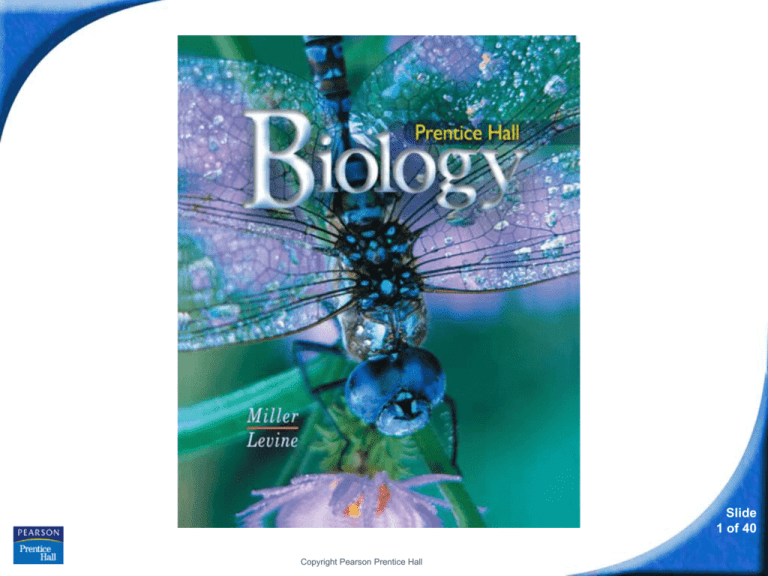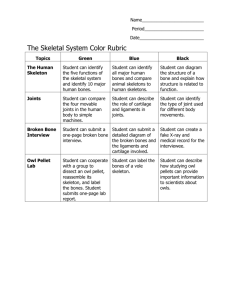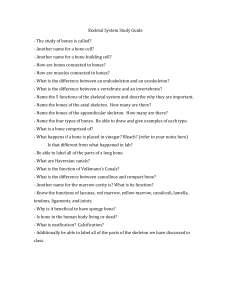
Biology
Slide
1 of 40
Copyright Pearson Prentice Hall
36–1 The Skeletal System
Slide
2 of 40
Copyright Pearson Prentice Hall
36–1 The Skeletal System
The Skeleton
(All organisms need structural support.
Unicellular organisms have a cytoskeleton.
Multicellular animals have either an exoskeleton
(arthropods) or an endoskeleton (vertebrates).)
Slide
3 of 40
Copyright Pearson Prentice Hall
36–1 The Skeletal System
The Skeleton
(The human skeleton is composed of bone.
Bones and other connective tissues, such as
cartilage and ligaments, form the skeletal system).
Slide
4 of 40
Copyright Pearson Prentice Hall
36–1 The Skeletal System
The Skeleton
What are the functions of the skeletal
system?
Slide
5 of 40
Copyright Pearson Prentice Hall
36–1 The Skeletal System
The Skeleton
A. The skeleton:
• 1. supports the body.
• 2. protects internal organs.
• 3. provides for movement.
• 4. stores mineral reserves.
• 5. provides a site for blood cell formation.
• Osteo=bone
Slide
6 of 40
Copyright Pearson Prentice Hall
36–1 The Skeletal System
The Skeleton
Skull
B. axial skeleton:
(blue) supports
central axis of body.
Sternum
Ribs
Vertebral
column
Axial Skeleton
Copyright Pearson Prentice Hall
Slide
7 of 40
36–1 The Skeletal System
The Skeleton
Clavicle
Scapula
C. Appendicular
Skeleton (grey):
Humerus
bones of arms and
shoulder area; pelvis
and legs
Radius
Pelvis
Ulna
Carpals
Metacarpals
Phalanges
Femur
Appendicular Skeleton
Copyright Pearson Prentice Hall
Patella
Fibula
Tibia
Tarsals
Metatarsals
Phalanges
Slide
8 of 40
36–1 The Skeletal System
Structure of Bones
Structure of Bones
What is the structure of a typical bone?
Slide
9 of 40
Copyright Pearson Prentice Hall
36–1 The Skeletal System
Structure of Bones
D. Bone Structure:
1. solid network of living cells
2. protein fibers surrounded by deposits of
calcium salts.
Slide
10 of 40
Copyright Pearson Prentice Hall
36–1 The Skeletal System
Structure of Bones
Haversian canal
Compact bone
Spongy bone
Compact bone
Periosteum
Spongy bone
Bone marrow
Osteocyte
Artery
Vein
Periosteum
Copyright Pearson Prentice Hall
Slide
11 of 40
36–1 The Skeletal System
Structure of Bones
(The bone is surrounded by a tough layer of
connective tissue called the periosteum.
Blood vessels in the periosteum carry oxygen and
nutrients to the bone. )
Slide
12 of 40
Copyright Pearson Prentice Hall
36–1 The Skeletal System
Structure of Bones
(Beneath the periosteum is a thick layer of compact
bone.
Running through compact bone is a network of tubes
called Haversian canals that contain blood vessels
and nerves.)
Slide
13 of 40
Copyright Pearson Prentice Hall
36–1 The Skeletal System
Structure of Bones
(Spongy bone is found inside the outer layer of
compact bone.
Spongy bone is also found in the ends of long bones
and in the middle of short, flat bones.
Spongy bone adds strength without adding mass.)
Slide
14 of 40
Copyright Pearson Prentice Hall
36–1 The Skeletal System
Structure of Bones
(Osteocytes, or mature bone cells, are embedded in
the bone matrix.
Other bone cells—osteoclasts and osteoblasts—line
the Haversian canals and the surfaces of compact
and spongy bone.
•
Osteoclasts break down bone.
•
Osteoblasts produce bone.)
Slide
15 of 40
Copyright Pearson Prentice Hall
36–1 The Skeletal System
Structure of Bones
E. Bone marrow:
soft tissue inside the cavities of bones.
F. 2 types of bone marrow:
•
1. Yellow marrow is made up of fat cells.
•
2. Red marrow produces red blood cells, some
kinds of white blood cells, and platelets.
Slide
16 of 40
Copyright Pearson Prentice Hall
36–1 The Skeletal System
Development of Bones
G. Development of Bones
1. skeleton of an embryo is composed of cartilage.
2. Cartilage:
* strong connective tissue that supports the body
* softer and more flexible than bone.
Slide
17 of 40
Copyright Pearson Prentice Hall
36–1 The Skeletal System
Development of Bones
H. Ossification:
Cartilage is replaced by bone
(Bone tissue forms as osteoblasts secrete mineral
deposits.
When the osteoblasts become surrounded by bone
tissue, they mature into osteocytes.)
Slide
18 of 40
Copyright Pearson Prentice Hall
36–1 The Skeletal System
I.
Development of Bones
Growth plates:
area at either end of long bone that cartilage
grows.
(Growth of cartilage at these plates causes bones to
lengthen. Gradually, this cartilage is replaced by
bone tissue.
By early adulthood, cartilage in the growth plates is
replaced by bone, the bones become ossified, and
growth stops.)
Slide
19 of 40
Copyright Pearson Prentice Hall
36–1 The Skeletal System
Types of Joints
J. Types of Joints
1.Joint:
place where one bone attaches to another bone
* permit bones to move without damaging
each other.
Slide
20 of 40
Copyright Pearson Prentice Hall
36–1 The Skeletal System
Types of Joints
What are the three different kinds of
joints?
Slide
21 of 40
Copyright Pearson Prentice Hall
36–1 The Skeletal System
Types of Joints
K. 3 kinds of joints:
(Classified depending on type of
movement)
Slide
22 of 40
Copyright Pearson Prentice Hall
36–1 The Skeletal System
Types of Joints
1. Immovable Joints
a. allow no movement.
b. bones are interlocked and held
together by connective tissue, or
they are fused together.
c. example: skull bones.
Slide
23 of 40
Copyright Pearson Prentice Hall
36–1 The Skeletal System
Types of Joints
2. Slightly Movable Joints
a. small amount of restricted movement.
b. example: adjacent vertebrae.
Slide
24 of 40
Copyright Pearson Prentice Hall
36–1 The Skeletal System
Types of Joints
3. Freely Movable Joints
a. movement in 1 or more directions.
b. 4 types freely movable joints:
1. ball-and-socket joints
2. hinge joints
3. pivot joints
4. saddle joints
Slide
25 of 40
Copyright Pearson Prentice Hall
36–1 The Skeletal System
Types of Joints
Ball-and-socket joints permit movement in many
directions.
Slide
26 of 40
Copyright Pearson Prentice Hall
36–1 The Skeletal System
Types of Joints
Hinge joints permit back-and-forth motion.
Slide
27 of 40
Copyright Pearson Prentice Hall
36–1 The Skeletal System
Types of Joints
Pivot joints allow one bone to rotate around another.
Slide
28 of 40
Copyright Pearson Prentice Hall
36–1 The Skeletal System
Types of Joints
Saddle joints permit one bone to slide in two
directions.
Slide
29 of 40
Copyright Pearson Prentice Hall
36–1 The Skeletal System
Structure of Joints
(Structure of Joints
In freely movable joints, cartilage covers the
surfaces where two bones come together.
Joints are also surrounded by a fibrous capsule
that holds the bones together while still allowing
them to move.)
Slide
30 of 40
Copyright Pearson Prentice Hall
36–1 The Skeletal System
Structure of Joints
Muscle
Knee Joint
Tendon
Femur
Patella
Bursa
Ligament
Synovial fluid
Cartilage
Fat
Fibula
Tibia
Slide
31 of 40
Copyright Pearson Prentice Hall
36–1 The Skeletal System
Structure of Joints
C. ligaments: hold bones together in joints
(Synovial fluid forms a thin lubricating film over the
surface of the joint.
Synovial fluid enables the bones to slide past each
other more smoothly.)
Slide
32 of 40
Copyright Pearson Prentice Hall
36–1 The Skeletal System
Structure of Joints
(In some freely movable joints small sacs of synovial
fluid called bursae form.
A bursa reduces the friction between bones of a joint
and also acts as a shock absorber.)
Slide
33 of 40
Copyright Pearson Prentice Hall
36–1 The Skeletal System
Skeletal System Disorders
4. Skeletal System Disorders
A.Excessive strain on a joint may produce
inflammation,
(in which excess fluid causes swelling, pain,
heat, and redness.)
B. Bursitis: Inflammation of a bursa
C. Arthritis: Inflammation of the joint
D. Osteoporosis: is caused by a loss of calcium in
the bone.
Slide
34 of 40
Copyright Pearson Prentice Hall
36–1
Click to Launch:
Continue to:
- or -
Slide
35 of 40
Copyright Pearson Prentice Hall
36–1
Red blood cells, some kinds of white blood cells,
and platelets are produced by
a. red marrow.
b. cartilage.
c. yellow marrow.
d. osteocytes.
Slide
36 of 40
Copyright Pearson Prentice Hall
36–1
Mature bone cells are called
a. periosteum.
b. osteocytes.
c. bone marrow.
d. Haversian canals.
Slide
37 of 40
Copyright Pearson Prentice Hall
36–1
In freely movable joints, what covers the
surfaces where the two bones come together?
a. ligaments
b. cartilage
c. bursae
d. tendons
Slide
38 of 40
Copyright Pearson Prentice Hall
36–1
During ossification, cartilage is replaced by
a. bone.
b. ligament.
c. marrow.
d. tendon.
Slide
39 of 40
Copyright Pearson Prentice Hall
36–1
The shoulder joint is an example of a
a. ball-and-socket joint.
b. hinge joint.
c. pivot joint.
d. saddle joint.
Slide
40 of 40
Copyright Pearson Prentice Hall
END OF SECTION






